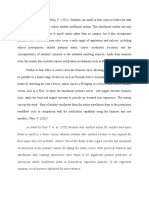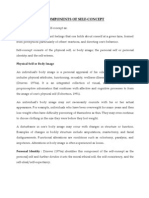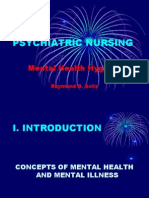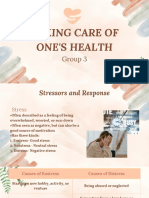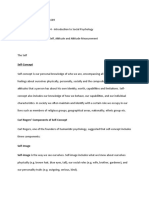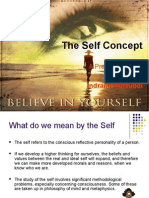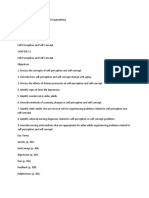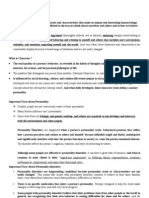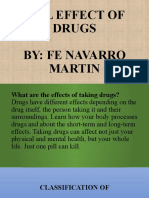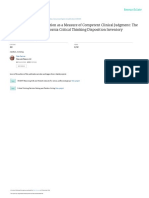0 ratings0% found this document useful (0 votes)
23 viewsAss Yvette
Ass Yvette
Uploaded by
Yaz GhorlSelf-concept is an individual's subjective view of themselves, including thoughts, attitudes, and perceptions. It directly impacts self-esteem. A positive self-concept is important for mental and physical health, as it allows people to develop relationships and resist illness. Self-concept is shaped by developmental stage, family/culture, stressors, resources, success/failure history, and illness. It has components including personal identity, body image, role performance, and self-esteem.
Copyright:
© All Rights Reserved
Available Formats
Download as DOCX, PDF, TXT or read online from Scribd
Ass Yvette
Ass Yvette
Uploaded by
Yaz Ghorl0 ratings0% found this document useful (0 votes)
23 views4 pagesSelf-concept is an individual's subjective view of themselves, including thoughts, attitudes, and perceptions. It directly impacts self-esteem. A positive self-concept is important for mental and physical health, as it allows people to develop relationships and resist illness. Self-concept is shaped by developmental stage, family/culture, stressors, resources, success/failure history, and illness. It has components including personal identity, body image, role performance, and self-esteem.
Original Title
ass-yvette
Copyright
© © All Rights Reserved
Available Formats
DOCX, PDF, TXT or read online from Scribd
Share this document
Did you find this document useful?
Is this content inappropriate?
Self-concept is an individual's subjective view of themselves, including thoughts, attitudes, and perceptions. It directly impacts self-esteem. A positive self-concept is important for mental and physical health, as it allows people to develop relationships and resist illness. Self-concept is shaped by developmental stage, family/culture, stressors, resources, success/failure history, and illness. It has components including personal identity, body image, role performance, and self-esteem.
Copyright:
© All Rights Reserved
Available Formats
Download as DOCX, PDF, TXT or read online from Scribd
Download as docx, pdf, or txt
0 ratings0% found this document useful (0 votes)
23 views4 pagesAss Yvette
Ass Yvette
Uploaded by
Yaz GhorlSelf-concept is an individual's subjective view of themselves, including thoughts, attitudes, and perceptions. It directly impacts self-esteem. A positive self-concept is important for mental and physical health, as it allows people to develop relationships and resist illness. Self-concept is shaped by developmental stage, family/culture, stressors, resources, success/failure history, and illness. It has components including personal identity, body image, role performance, and self-esteem.
Copyright:
© All Rights Reserved
Available Formats
Download as DOCX, PDF, TXT or read online from Scribd
Download as docx, pdf, or txt
You are on page 1of 4
1.) What is self concept?
It is an individual’s view of self. It is a subjective view and a complex mixture of unconscious
and conscious thoughts, attitudes, and perceptions. Self-concept, or how a person thinks about
oneself, directly affects self-esteem, or how one feels about oneself.
Self-concept is one’s mental image of oneself. A positive self-concept is essential to a person’s
mental and physical health. Individuals with a positive self-concept are better able to develop and
maintain interpersonal relationships and resist psychological and physical illness. An individual
possessing a strong self-concept should be better able to accept or adapt to changes that may
occur over the life span. How one views oneself affects one’s interaction with others.
(Nurses have a responsibility to assess clients for a negative self-concept and to identify the possible causes in order to help them
develop a more positive view of themselves. Individuals who have a poor self-concept may express feelings of worthlessness, self-
dislike, or even self-hatred. They may feel sad or hopeless, and may state they lack energy to perform even the simplest of tasks).
2.) Stages in self-concept?
3.) Characteristics of self-concept?
4.) Factors affecting self-concept
Many factors affect a person’s self-concept. Major factors are stage of development, family and culture,
stressors, resources, history of success and failure, and illness.
Stage of Development - As an individual develops, the conditions that affect the self-concept change. For
example, an infant requires a supportive, caring environment, whereas a child requires freedom to explore
and learn. Older adults’ self-concept is based on their experiences in progressing through life’s stages.
Family and Culture - A young child’s values are largely influenced by the family and culture. Later on,
peers influence the child and thereby affect the sense of self. When the child is confronted by differing
expectations from family, culture, and peers, the child’s sense of self is often confused.
Stressors – It can strengthen the self-concept as an individual cope’s successfully with problems. On the
other hand, overwhelming stressors can cause maladaptive responses including substance abuse,
withdrawal, and anxiety. The ability of a person to handle stressors will largely depend on personal
resources. It is important for the nurse to identify any stressors that may affect aspects of the self-concept.
Resources - An individual’s resources are internal and external. Examples of internal resources include
confidence and values, whereas external resources include support network, sufficient finances, and
organizations. Generally the greater the number of resources a person has and uses, the more positive the
effect on the self-concept.
History of Success and Failure - People who have a history of failures come to see themselves as
failures, whereas people with a history of successes will have a more positive self-concept. Likewise,
individuals with a positive self-concept tend to find contentment in their level of success, whereas a
negative self-concept can lead to viewing one’s life situation as negative.
Illness - Illness and trauma can also affect an individual’s self-concept. A woman who has had a
mastectomy may see herself as less attractive, and the loss may affect how she acts and values herself.
People respond to stressors such as illness and alterations in function related to aging in a variety of
ways. Acceptance, denial, withdrawal, and depression are common reactions.
Stressors Affecting Self-Concept
IDENTITY STRESSORS • Change in physical appearance (e.g., facial wrinkles) • Declining physical,
mental, or sensory abilities • Inability to achieve goals • Relationship concerns • Sexuality concerns •
Unrealistic ideal self. BODY IMAGE STRESSORS • Loss of body parts (e.g., amputation, mastectomy,
hysterectomy) • Loss of body functions (e.g., from stroke, spinal cord injury, neuromuscular disease,
arthritis, declining mental or sensory abilities) • Disfigurement (e.g., through pregnancy, severe burns,
facial blemishes, colostomy, tracheostomy) • Unrealistic body ideal (e.g., a muscular configuration that
cannot be achieved). ROLE STRESSORS • Loss of parent, spouse, child, or close friend • Change or
loss of job or other significant role • Divorce • Illness of self or others that affects role performance •
Ambiguous or conflicting role expectations • Inability to meet role expectations. SELF-ESTEEM
STRESSORS • Lack of positive feedback from significant others • Repeated failures • Unrealistic
expectations • Abusive relationship • Loss of financial security.
5.) Components self-concept?
Personal Identity – It is the conscious sense of individuality and uniqueness that is continually evolving
throughout life. People often view their identity in terms of name, gender, age, race, ethnic origin or
culture, occupation or roles, talents, and other situational characteristics (e.g., marital status and
education). Personal identity also includes beliefs and values, personality, and character. For instance, is
the person outgoing, friendly, reserved, generous, selfish? Personal identity thus encompasses both the
tangible and factual, such as name and sex, and the intangible, such as values and beliefs. Identity is what
distinguishes self from others. A person with a strong sense of identity has integrated body image, role
performance, and self-esteem into a complete self-concept. This sense of identity provides a person with a
feeling of continuity and a unity of personality. Furthermore, the individual sees himself or herself as a
unique person.
Body Image - The image of physical self, or body image, is how a person perceives the size, appearance,
and functioning of the body and its parts. Body image has both cognitive and affective aspects. The
cognitive is the knowledge of the material body; the affective includes the sensations of the body, such as
pain, pleasure, fatigue, and physical movement. Body image is the sum of these attitudes, conscious and
unconscious, that a person has toward his or her body.
Role Performance - Throughout life, people undergo numerous role changes. A role is a set of
expectations about how the person occupying a particular position behaves. Role performance is how a
person in a particular role behaves in comparison to the behaviors expected of that role. Role mastery
means that the person’s behaviors meet role expectations. Role development involves socialization into a
particular role. For example, nursing students are socialized into nursing through exposure to their
instructors, clinical experience, classes, laboratory simulations, and seminars. Role ambiguity occurs
when expectations are unclear, and people do not know what to do or how to do it and are unable to
predict the reactions of others to their behavior. Failure to master a role creates frustration and feelings of
inadequacy, often with consequent lowered self-esteem. Role conflicts arise from opposing or
incompatible expectations. In an interpersonal conflict, people have different expectations about a
particular role. People undergoing role strain are frustrated because they feel or are made to feel
inadequate or unsuited to a role. Role strain is often associated with sex role stereotypes.
Self-Esteem - It is one’s judgment of one’s own worth, that is, how that person’s standards and
performances compare to others’ standards and to one’s ideal self. If a person’s self-esteem does not
match with the ideal self, then low self-concept results. The two types of self-esteem are global and
specific. Global self-esteem is how much one likes oneself as a whole. Specific self-esteem is how much
one approves of a certain part of oneself.
1.) what is stress?
It is the body’s physiological or psychological reaction to any stimulus that evokes a change.
It is the emotional and physical strain caused by our response to pressure from the outside world.
Common stress reactions include tension, irritability, inability to concentrate, frustration and a
variety of physical symptoms that include headache and a fast heartbeat.
2.) What is coping?
Coping is action directed at the resolution or mitigation of a problematic situation .
The ways we try to change or interpret circumstances to make them less threatening.
In nursing it is Simply defined, coping, is the patient's ability to institute, maintain and regain
psychological homeostasis when this homeostasis is disrupted for one reason or another. Coping
can be adaptive and it can also be useless and maladaptive.
3.) Three general approaches for coping
4.) what is adaptive and maladaptive coping?
Maladaptive coping strategies are those that attempt to manage stress, but end up decreasing function
despite temporary respite from certain symptoms.
Adaptive coping strategies generally involve confronting problems directly, making reasonably realistic
appraisals of problems, recognizing and changing unhealthy emotional reactions, and trying to prevent
adverse effects on the body.
5.) what is adaptation?
It is an ongoing process by which individuals adjust to stressors in order to achieve homeostasis
(homeostasis; equilibrium between physiological, psychological, sociocultural, intellectual, & spiritual
needs).
6.) Differentiate GAS and LAS
You might also like
- Nursing Process Lecture NotesDocument16 pagesNursing Process Lecture NotesReden Ocampo100% (18)
- Resilience Processes in Development: Four Waves of Research On Positive Adaptation in The Context of AdversityDocument24 pagesResilience Processes in Development: Four Waves of Research On Positive Adaptation in The Context of Adversityasmita sainiNo ratings yet
- Finding Flow - Mihaly Csikszentmihalyi PDFDocument191 pagesFinding Flow - Mihaly Csikszentmihalyi PDFYee Mon Aung100% (11)
- Introduction To The Physical SelfDocument5 pagesIntroduction To The Physical SelfMaika Narciso100% (2)
- RRLDocument6 pagesRRLYaz GhorlNo ratings yet
- Self ConceptDocument23 pagesSelf ConceptPamella Guntala67% (3)
- Components of SelfDocument4 pagesComponents of SelfManwinder Singh Gill88% (8)
- Elliot Greenebaum: How Do You Get This Way?Document4 pagesElliot Greenebaum: How Do You Get This Way?ksenijapNo ratings yet
- Motivating StudentsDocument9 pagesMotivating StudentsAgrippa Mungazi100% (1)
- Cafs NotesDocument36 pagesCafs NotesAlanahNo ratings yet
- Self ConceptDocument35 pagesSelf ConceptKirtesh Savaliya100% (1)
- Promoting Self Esteem: Presented by Shilpa Hotakar MSC Nursing Dept of Psychiatric NursingDocument23 pagesPromoting Self Esteem: Presented by Shilpa Hotakar MSC Nursing Dept of Psychiatric NursingShilpa Vhatkar50% (2)
- Psychiatric 2 Nursing-LectureDocument183 pagesPsychiatric 2 Nursing-LectureHarley Justiniani Dela CruzNo ratings yet
- Components of Self-Concept: Physical Self or Body ImageDocument4 pagesComponents of Self-Concept: Physical Self or Body ImageChuk OjNo ratings yet
- Self ConceptDocument9 pagesSelf ConcepthkhnNo ratings yet
- Understanding The SelfDocument34 pagesUnderstanding The SelfAnaliza GinezaNo ratings yet
- Components of Self-ConceptDocument4 pagesComponents of Self-ConceptGeno Adrian T PampangaNo ratings yet
- Shagun Verma Attitude & Job SatisfactionDocument56 pagesShagun Verma Attitude & Job SatisfactionShagun VermaNo ratings yet
- Perdev RreviewerDocument13 pagesPerdev RreviewerGracia Mae GaciasNo ratings yet
- I. Life Skills (16 Hours) Provide Case For ComponentsDocument56 pagesI. Life Skills (16 Hours) Provide Case For ComponentsEyob DestaNo ratings yet
- Mental HealthDocument45 pagesMental HealthRyzzaYvonneSaclausoMedalleNo ratings yet
- Defining The SelfDocument6 pagesDefining The SelfTaniaNo ratings yet
- Intra Personal and Interpersonal SkillsDocument11 pagesIntra Personal and Interpersonal SkillsGhost burns100% (1)
- Essay On Self ConceptDocument3 pagesEssay On Self ConceptCassidyNo ratings yet
- In Others: Police Sports Team Faith Trust SynonymsDocument6 pagesIn Others: Police Sports Team Faith Trust Synonymsnovilia eka sariNo ratings yet
- PsychopathophysiologyDocument13 pagesPsychopathophysiologyJechelle Ann Pabustan Martin-BoniquitNo ratings yet
- The Physical SelfDocument4 pagesThe Physical Selfpaul.betongNo ratings yet
- Theories of PersonalityDocument39 pagesTheories of PersonalityaiemyoptimusNo ratings yet
- CHAPTER NINE Syco AssigmentDocument5 pagesCHAPTER NINE Syco Assigmentyonathantesfaye51No ratings yet
- Unit 3 Notes Mba 1-1Document10 pagesUnit 3 Notes Mba 1-1ARAYN DIXITNo ratings yet
- PER-DEV ReviewerDocument7 pagesPER-DEV ReviewerReniel V. Broncate (REHNIL)No ratings yet
- ncm105 /mental HealthDocument8 pagesncm105 /mental Healthneleh grayNo ratings yet
- Psyc1004 A1Document11 pagesPsyc1004 A1Deadly ChillerNo ratings yet
- Foundation Exam 3 ReviewDocument12 pagesFoundation Exam 3 Reviewmiavillarreal34No ratings yet
- The Self ConceptDocument55 pagesThe Self Conceptshivakumar NNo ratings yet
- Lesson 7 Mental Health and Well Being in Middle and Late AdolescenceDocument13 pagesLesson 7 Mental Health and Well Being in Middle and Late Adolescenceevgenovia7404qcNo ratings yet
- Lesson 1 To 4 PERDEVDocument6 pagesLesson 1 To 4 PERDEVCollene MosaNo ratings yet
- Final Self ConceptDocument30 pagesFinal Self Conceptamaninder71100% (1)
- Self and RelationshipsDocument59 pagesSelf and Relationshipsmansi123tilwankarNo ratings yet
- CFLM 412Document93 pagesCFLM 412Ree Ann AdlawanNo ratings yet
- PPT_GEd_101-WEEK_2Document23 pagesPPT_GEd_101-WEEK_2Alexa Camille MaglaqueNo ratings yet
- Lesson 1Document6 pagesLesson 1Briones, Francine Claire, G.No ratings yet
- Module 4Document38 pagesModule 4IMS AcadNo ratings yet
- EuthenicsDocument17 pagesEuthenicspewpewna22No ratings yet
- Inclusiveness Chapter 3Document51 pagesInclusiveness Chapter 3Teme DanaNo ratings yet
- Understanding Self Module 1Document17 pagesUnderstanding Self Module 1shettyNo ratings yet
- OB Chap 2Document29 pagesOB Chap 2Hazel VakhariaNo ratings yet
- PD 9Document11 pagesPD 9Jem RoqueNo ratings yet
- 1OE - Unit 2Document8 pages1OE - Unit 2Diya SarkarNo ratings yet
- Chapter 1 Introduction To Personal DevelopmentDocument17 pagesChapter 1 Introduction To Personal DevelopmentJacob SanchezNo ratings yet
- ExplainDocument4 pagesExplainJoshua CudalNo ratings yet
- Nurse Key FasteDocument9 pagesNurse Key Fastetesfamichael mengistuNo ratings yet
- Personality DisordersDocument39 pagesPersonality DisordersCzar Ian AgbayaniNo ratings yet
- Think Big, Achieve More: Cultivating a Growth Mindset for Lifelong SuccessFrom EverandThink Big, Achieve More: Cultivating a Growth Mindset for Lifelong SuccessNo ratings yet
- Social PerceptionDocument9 pagesSocial Perceptioniamsathya2005No ratings yet
- Pratishtha NathwaniDocument36 pagesPratishtha NathwanipratishthanathwaniNo ratings yet
- Self Estream PptDocument52 pagesSelf Estream PptPihu SalamNo ratings yet
- psychopathology:-: Unit 1Document22 pagespsychopathology:-: Unit 1BlackSpider SpiderNo ratings yet
- Human Behavior in Organization Midterm LecturesDocument8 pagesHuman Behavior in Organization Midterm Lecturesjhaycelaguilar4No ratings yet
- Self Concept & Self Esteem NehadDocument41 pagesSelf Concept & Self Esteem NehadHamss AhmedNo ratings yet
- Trabajo OrganizacionalDocument13 pagesTrabajo OrganizacionalvalentinaNo ratings yet
- Unit - 3 Self Perception & Self ConceptDocument38 pagesUnit - 3 Self Perception & Self Conceptzainishbashir9No ratings yet
- Mpce 46Document16 pagesMpce 46xicacol947No ratings yet
- Abuse CounsellingDocument4 pagesAbuse CounsellingAbhishek UpadhyayNo ratings yet
- Mental HealthDocument19 pagesMental Healthsfkendall948No ratings yet
- Week 4 5 HandoutDocument36 pagesWeek 4 5 HandoutCeline JoyNo ratings yet
- Body Language and BehaviourDocument4 pagesBody Language and Behaviourmrn69092No ratings yet
- Positive Minds, Successful Lives: How to Harness the Power of Thought for Personal Growth and SuccessFrom EverandPositive Minds, Successful Lives: How to Harness the Power of Thought for Personal Growth and SuccessNo ratings yet
- Batulan, Sherickha Ivette T. BSN 1-C Exercise 3 MicroPara LabDocument5 pagesBatulan, Sherickha Ivette T. BSN 1-C Exercise 3 MicroPara LabYaz GhorlNo ratings yet
- Batulan, Sherickha Ivette T. BSN 1-C Exercise 3 MicroPara LabDocument5 pagesBatulan, Sherickha Ivette T. BSN 1-C Exercise 3 MicroPara LabYaz GhorlNo ratings yet
- Ted TalkDocument9 pagesTed TalkYaz GhorlNo ratings yet
- Mija Rimay - Questions For SDDocument4 pagesMija Rimay - Questions For SDYaz GhorlNo ratings yet
- UntitledDocument2 pagesUntitledYaz GhorlNo ratings yet
- Case StudyDocument3 pagesCase StudychelseajoygananNo ratings yet
- Schema Therapy Conceptualization of Personality Functioning and Traits in ICD 11 and DSM 5Document12 pagesSchema Therapy Conceptualization of Personality Functioning and Traits in ICD 11 and DSM 5María González MartínNo ratings yet
- GroupD - BUS485 ProposalDocument18 pagesGroupD - BUS485 ProposalRabeya JuiNo ratings yet
- 3.3 Motivation TheoriesDocument15 pages3.3 Motivation TheoriessistemaelectricoNo ratings yet
- Nine Steps To More Effective ParentingDocument14 pagesNine Steps To More Effective ParentingRonalie ReyesNo ratings yet
- Academic Stress and Domains of Learning Among Grade 10 Students: Basis For Student's Development ProgramDocument43 pagesAcademic Stress and Domains of Learning Among Grade 10 Students: Basis For Student's Development Programelijah maeNo ratings yet
- Attitudes and BehaviorDocument29 pagesAttitudes and Behaviormrudhula blessonNo ratings yet
- Journal of Sex & Marital TherapyDocument16 pagesJournal of Sex & Marital TherapyINSTITUTO VIDANo ratings yet
- Self-Esteem, Shyness, and Sociability in Adolescents With Specific Language Impairment (SLI)Document15 pagesSelf-Esteem, Shyness, and Sociability in Adolescents With Specific Language Impairment (SLI)Gina Carmen FășieNo ratings yet
- Module 2.1 The Physical SelfDocument7 pagesModule 2.1 The Physical SelfPhillip Armand LajomNo ratings yet
- Self ConceptDocument3 pagesSelf ConceptLarete PaoloNo ratings yet
- Nurses Role in Promotion of Self-EsteemDocument2 pagesNurses Role in Promotion of Self-EsteemhdjndijriifNo ratings yet
- GE 1 Understanding The Self MODULE 8Document3 pagesGE 1 Understanding The Self MODULE 8klare montelNo ratings yet
- Stress ModelsDocument31 pagesStress ModelsnidhidarklordNo ratings yet
- Care Plan On AlzheimerDocument4 pagesCare Plan On Alzheimeranimesh pandaNo ratings yet
- Ill Effect of Drugs PresentationDocument37 pagesIll Effect of Drugs PresentationManuel LisondraNo ratings yet
- Chapter 6Document7 pagesChapter 6Nhi Nguyễn Ngọc PhươngNo ratings yet
- CompetentClinicalJdgmjnt CCTDI 94 JNEdDocument14 pagesCompetentClinicalJdgmjnt CCTDI 94 JNEd9 PsychologyNo ratings yet
- Assessment in Affective DomainDocument6 pagesAssessment in Affective Domainfries riveraNo ratings yet
- Social Media and Mental Health in Adolescents Hussein ChahineDocument10 pagesSocial Media and Mental Health in Adolescents Hussein Chahinejosephmainam9No ratings yet
- Raising Low Self-Esteem - NHSDocument5 pagesRaising Low Self-Esteem - NHSAbdullahi ChuwachuwaNo ratings yet
- Self ConfidenceDocument59 pagesSelf ConfidenceSenyor Leonard100% (1)
- Personality Is A Patterned Body of HabitsDocument21 pagesPersonality Is A Patterned Body of HabitsSunny100% (1)




